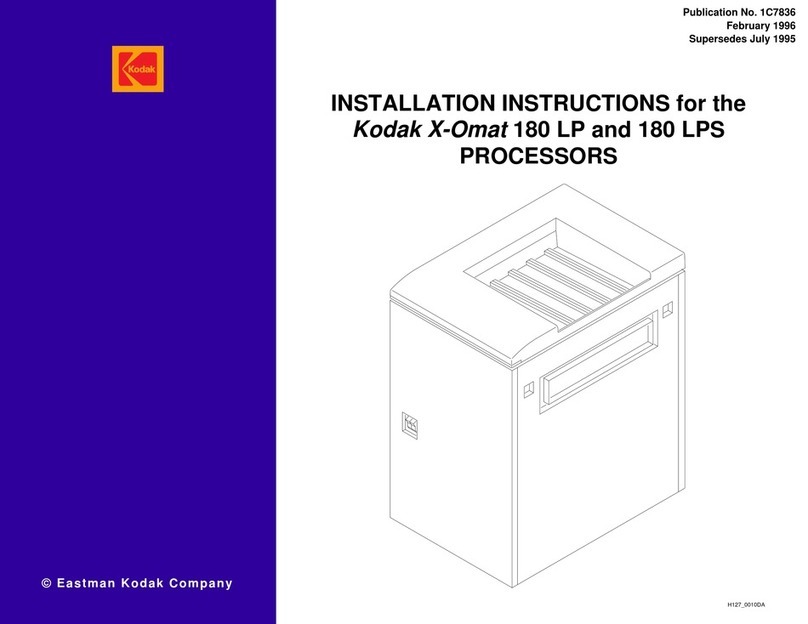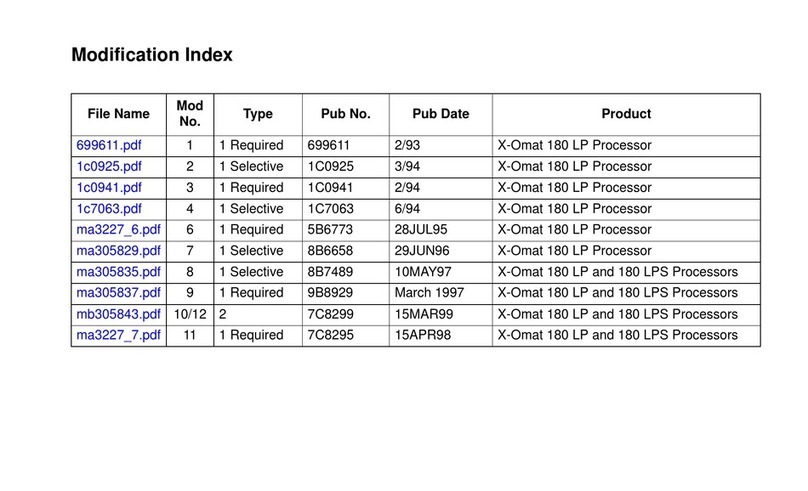
2 May 1997 – 5B6729
PLEASE NOTE The information contained herein is based on the experience and knowledge relating to the
subject matter gained by Eastman Kodak Company prior to publication.
No patent license is granted by this information.
Eastman Kodak Company reserves the right to change this information without notice, and
makes no warranty, express or implied, with respect to this information. Kodak shall not be liable
for any loss or damage, including consequential or special damages, resulting from any use of
this information, even if loss or damage is caused by Kodak’s negligence or other fault.
Warning
To avoid hazardous conditions, keep floors and floor coverings around your
Kodak X-Omat
Processor and
associated drains clean and dry at all times. Any accumulation of fluids from mixing tanks, drain lines, etc, should
be cleaned up immediately. In the event of an accumulation of liquid due to backup, overflow, or other malfunctions
of the drain associated with your
Kodak X-Omat
Processor, call a plumber or other contractor to correct any problem
with the drain. Kodak accepts no responsibility or liability whatsoever for the serviceability of any drain connected to
or associated with a
Kodak X-Omat
Processor. Such drains are the sole responsibility of the customer.
Description Page
Table of Contents
Introduction . . . . . . . . . . . . . . . . . . . . . . . . . . . . . . . . . . . . . . . . . . . . . . . . . . . . . . . . . . . . 4
Intended Audience . . . . . . . . . . . . . . . . . . . . . . . . . . . . . . . . . . . . . . . . . . . . . . . 4
How To Use this Manual . . . . . . . . . . . . . . . . . . . . . . . . . . . . . . . . . . . . . . . . . . 4
Overview . . . . . . . . . . . . . . . . . . . . . . . . . . . . . . . . . . . . . . . . . . . . . . . . . . . . . . . . . . . . . . 5
Product Description . . . . . . . . . . . . . . . . . . . . . . . . . . . . . . . . . . . . . . . . . . . . . . 5
Identifying the Covers and Panels and Other Components of the Processor . . 6
Using the Display Panel. . . . . . . . . . . . . . . . . . . . . . . . . . . . . . . . . . . . . . . . . . . 7
Adjusting the Contrast of the Display Panel . . . . . . . . . . . . . . . . . . . . . . . . . . . 8
Enabling the Auto Dimming Feature . . . . . . . . . . . . . . . . . . . . . . . . . . . . . . . . 8
Adjusting the Intensity of the Interface Control Panel . . . . . . . . . . . . . . . . . . . . 8
Using the Access Code . . . . . . . . . . . . . . . . . . . . . . . . . . . . . . . . . . . . . . . . . . . 9
Changing the Access Code . . . . . . . . . . . . . . . . . . . . . . . . . . . . . . . . . . . . . . . . 9
Limiting Access to the Processor Setup. . . . . . . . . . . . . . . . . . . . . . . . . . . . . . . 11
Changing the User Access . . . . . . . . . . . . . . . . . . . . . . . . . . . . . . . . . . . . . . . . 11
Operating Characteristics. . . . . . . . . . . . . . . . . . . . . . . . . . . . . . . . . . . . . . . . . . 12
Operating Instructions . . . . . . . . . . . . . . . . . . . . . . . . . . . . . . . . . . . . . . . . . . . . . . . . . . . . 13
Performing the Daily Start-Up Procedure. . . . . . . . . . . . . . . . . . . . . . . . . . . . . . 13
Performing the Shutdown Procedure . . . . . . . . . . . . . . . . . . . . . . . . . . . . . . . . 14
Film Feeding. . . . . . . . . . . . . . . . . . . . . . . . . . . . . . . . . . . . . . . . . . . . . . . . . . . . 15
Default Setpoints and Configurations. . . . . . . . . . . . . . . . . . . . . . . . . . . . . . . . . . . . . . . . . 17
Summary of Default Settings . . . . . . . . . . . . . . . . . . . . . . . . . . . . . . . . . . . . . . . . . . . . . . 17
Basic Setup Options. . . . . . . . . . . . . . . . . . . . . . . . . . . . . . . . . . . . . . . . . . . . . . . . . . . . . . 19
Selecting a Film Processing Cycle . . . . . . . . . . . . . . . . . . . . . . . . . . . . . . . . . . . . . . 19
Procedure for Selecting the Rapid, Standard, or Extended Cycle: . . . . . . . . . . 20
Procedure for Selecting the K/RA Cycle: . . . . . . . . . . . . . . . . . . . . . . . . . . . . . 20
Setting the Dryer Setpoint Temperature . . . . . . . . . . . . . . . . . . . . . . . . . . . . . . . . . . 22
Setting the Time and Date . . . . . . . . . . . . . . . . . . . . . . . . . . . . . . . . . . . . . . . . . . . . . 23
Displaying the Time and Date . . . . . . . . . . . . . . . . . . . . . . . . . . . . . . . . . . . . . . . . . . 25
Calibrating the Replenishment System . . . . . . . . . . . . . . . . . . . . . . . . . . . . . . . . . . . 26
Selecting a Replenishment Mode . . . . . . . . . . . . . . . . . . . . . . . . . . . . . . . . . . . . . . . 28
Selecting the Standby Mode . . . . . . . . . . . . . . . . . . . . . . . . . . . . . . . . . . . . . . . . . . . 30






























